
Sri Ramanandacharya was a 14th-century Vaishnava devotional poet saint, who lived in the Gangetic basin of northern India. The Hindu tradition recognizes him as the founder of the Ramanandi Sampradaya, the largest monastic Hindu renunciant community in modern times.

Bishnoi is a community found in the Western Thar Desert and northern states of India. They follow a set of 29 principles/commandments given by Guru Jambheshwar (1451-1536). As of 2019, there are an estimated 600,000 followers of Bishnoi Panth residing in north and central India. Shree Guru Jambheshwar founded the sect at Samrathal Dhora in 1485 and his teachings, comprising 120 shabads, are known as Shabadwani. He preached for the next 51 years, travelling across India. The preaching of Guru Jambhoji inspires his followers as well as environmental protectors. Bishnoi sect admitted members from a variety of castes including Jats, Bania, Charans, Rajputs, and Brahmins.
Baladeva Vidyabhushana was an Indian Gaudiya Vaishnava acharya. Despite being renowned all over the world as the Gaudiya Vedanta Acarya, the scarcity of available authentic biodata has led misinformed authors to spread incorrect information about his life incidents. There is no known historical evidence regarding either his birthplace or date, nor any known reference to it in his works. Some wrongly believe that he disappeared in 1768. Yet his Aisvarya-kadambini is dated 1779. The original manuscript is preserved at the City Palace in Jaipur. While his birth date is unknown, a document preserved at the Jaipur Archives dated the fourteenth day of the Bhadra month of Saṁvat 1850 describes his ceremony of condolence presided by King Pratap Singh of Jaipur. On the basis of this evidence, it is unrealistic to assume that he was born much before 1700 AD.
Govinda Bhashya is a Gaudiya Vaishnava commentary (bhasya) on the Vedanta Sutra. It was written in the year 1628 Sakabda at Galtaji (Galta) near the present city of Jaipur, Rajasthan, by Baladeva Vidyabhushana to defend Gaudiya Vaishnava theology.

Hindaun is a city and municipality, near city of Karauli in Karauli district, Rajasthan, India. It has a population of 105690 and is governed by a municipal council.
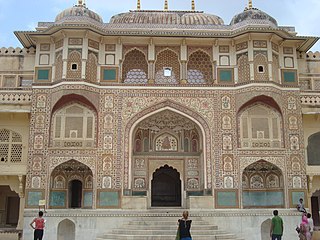
Jaipur District is a district of the state of Rajasthan in Northern India. The city of Jaipur, which is Rajasthan's capital and largest city, is the district headquarters. It is the tenth most populous district in India.
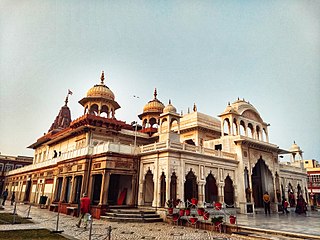
Karauli District is a district of Rajasthan in western India. It is located in the Braj region. The town of Karauli is the district headquarters. Karauli District comes under Bharatpur Divisional Commissionerate. Karauli is famous for popular red-stone.
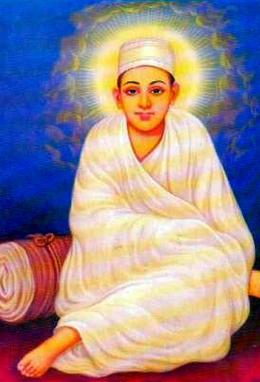
Dadu Dayal Ji was a poet-sant from Gujarat, India, a religious reformer who spoke against formalism and priestcraft.

The Ramanandi, also known as Ramavats, Ramananda sect is the largest sect of Vaishnavas, out of 52 gates of Vaishnavism, 36 are held by Ramanandi's. They mainly emphasize the worship of Rāma, Sita, and Hanuman, as well as Vishnu directly and also his other avatars.
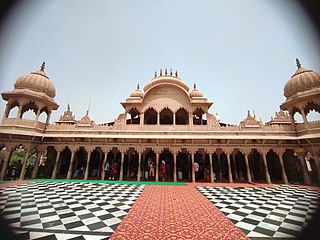
Barsana is a historical town and nagar panchayat in the Mathura district of the state of Uttar Pradesh, India. The town holds cultural and religious significance as it is the birthplace and home of the Hindu goddess Radha, the chief consort of Krishna. Barsana is situated in the Braj region. The main attraction of the town is the historical Radha Rani Temple which attracts huge number of devotees throughout the year.

Bhagat Pipa, also known as Pratap Singh Raja Pipaji, Rao Pipa, Sardar Pipa, Sant Pipaji, or Pipa Bairagi was a Rajput King of Gagaraungarh who abdicated the throne to become a Hindu mystic poet and saint of the Bhakti movement. He was born in the Malwa region of North India in approximately AD 1425.

Badrinath or Badrinarayana Temple is a Hindu temple dedicated to Vishnu. It is situated in the town of Badrinath in Uttarakhand, India. The temple is also one of the 108 Divya Desams dedicated to Vishnu - holy shrines for Vaishnavas - who is worshipped as Badrinath. It is open for six months every year, because of extreme weather conditions in the Himalayan region. The temple is located in Garhwal hill tracks in Chamoli district along the banks of Alaknanda River. It is one of the most visited pilgrimage centers of India, having recorded 2.8 million visits in just 2 months in 2022. It is one of the Char Dham pilgrimage sites.

Ram Charan (1720–1799)) is the Rajasthani Hindu guru, inspirator of a religious tradition called Ramsnehi Sampradaya or Ramdwara. He initiated and illustrated Nirguna (absolute) Bhakti, although he was not against Saguna Bhakti. He initiated and tried to eliminate "show", blind faith, hypocrisy and misled existing in the Hindu religion and preferred to worship the 'name of God', Rama, over God, to not get involved in false "show" activities.
Religion and spirituality, a pilgrimage is a long journey or search of great moral significance. Sometimes, it is a journey to a sacred place or shrine of importance to a person's beliefs and faith. Members of every major religion participate in pilgrimages. A person who makes such a journey is called a pilgrim.
Sita Kund is a Hindu pilgrimage site that honours the birthplace of the goddess, Sita. The Punaura Dham Janki Mandir is a Hindu pilgrimage site in Sitamarhi district, Bihar, which has an ancient Hindu temple. It is situated 5 km west of Sitamarhi City and a popular visitor's attraction.

Bhaktamal, written c. 1585, is a poem in the Braj language that gives short biographies of more than 200 bhaktas. It was written by Nabha Dass, a saint belonging to the tradition of Ramananda. Though considered a hagiography by some, the work recounts no miraculous events, and is widely believed to be an unbiased account of bhaktas across all sectarian paths. The Bhaktamal gives the earliest reliable account of many bhaktas, and hence is considered an important source for literary and devotional history of northern India.For example, Bhaktamal mentions about peity of Ramanandi saint Shri Bhagwanji of Gurdaspur and miraculous powers of his disciple Shri Narainji, who founded the Ramanandi Vaishnav temple named Thakurdwara Bhagwan Narainji in Pandori dham in Gurdaspur, Punjab.
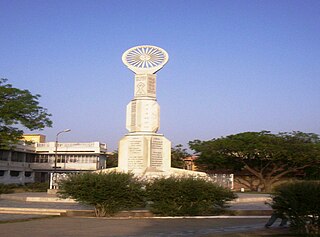
Hindaun is a Block in Karauli district of the Indian state of Rajasthan in Northern India. It is a subdivisional headquarter. Its population is approximately 442,000. The block covers an area of 700 Square kilometres, which makes it the biggest block in Karauli. The subdistrict code of Hindaun Block is 00522. There are about 165 villages in Hindaun Block.
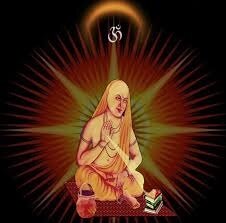
Nabha Dass was a saint, theologian and author of the Bhaktamal. In this sacred scripture, Nabha Das wrote the life history of almost every saint ranging from the Satya Yuga to the Kali Yuga age. Nabha Dass wrote ‘Bhagatmal’ in 1585. Nabha Dass, a saint belonging to the tradition of Ramananda. On his birthday 8 April, millions of followers remember him and his resolve to work for humanity.

Thakurdwara Bhagwan Narainji is a historical Hindu temple belonging to Ramanandi sampradaya, located in the village Pandori Mahantan in Gurdaspur district of Punjab in India. It constitutes one of the fifty-two Vaishnav dvaras of Indian subcontinent into which Bairagis have been organized. The shrine was founded by Ramanandi saint Shri Bhagwanji and his disciple ShriNarainji after whom the shrine has been named. The celebrated Vaishnav text Bhaktamala authored by Bhakt Nabhadas ji records the piety of Shri Bhagwanji and his disciple Shri Narainji. The temple is known for its spectacular Baisakhi fair.



















